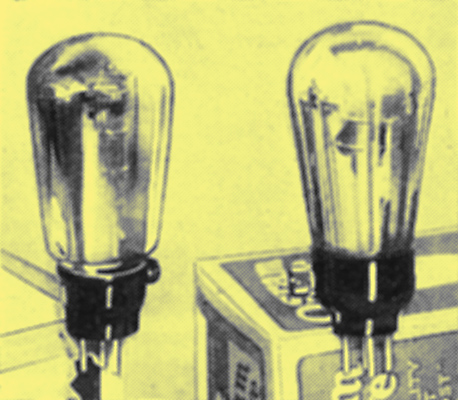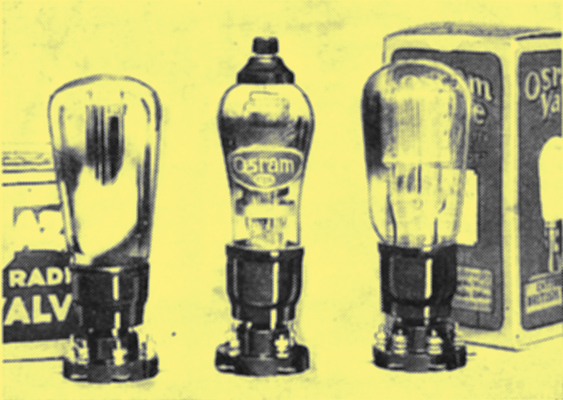|
Many notable advances have been made in the design of mains valves, and here they are described.

The DPT and the DH, two of the Osram indirectly-heated DC valves.
The mains valve that has created the most interest during the last few weeks is undoubtedly the variable-mu type of screened-grid valve. Marconi and Osram members of this type are known as VMS4, While the Mullard variable-mu valve is called the MM4V, and has a slope of 3.5.
The variable-mu valve needs some explaining, perhaps, but this can be done quite simply. The ordinary SG valve has not got a quite straight characteristic when operating under normal bias conditions. Also, if bias is increased the curvature becomes more curved, and so it is useless to try and get the valve to deal with more input by biasing it down to prevent overloading, as linear amplification will not be obtained.
Cross-Modulation Avoided
This gives rise to cross modulation and other faults, and it is in an attempt to remedy this that the variable-mu valves have been designed, Which will automatically reduce or increase their amplifying powers in accordance with the grid bias, and so the valves can be set to have either high or low mutual conductances. Another valve that is worth note is the Pentode. This has been introduced by Cossor's, and is a screened pentode capable of handling comparatively large HF inputs before rectification, or partial rectification due to overloading, commences; it also makes a useful power grid detector.
Mazda's have evolved a still more sensitive valve than their famous AC/SG in the AC/S2. This is a real star turn, for it has a slope of 5, an impedance of 600,000 Ohms, and the wonderful amplification factor of 3,000.
Nothing like this in stage gain can be obtained, of course, but with efficient coils and good screening a very much higher amplification per stage should be available with this valve than with the older type.
The Mazda PP5/400 is a more or less old friend, having been introduced some nine months ago, but it has been improved since then and has met with wide popularity among large-output mains users.
Undistorted Output of 5 watts
As our readers may remember, it is a 400 Volt anode, steep slope, directly-heated AC valve capable of providing an undistorted output of 5 Watts.
Indirectly-heated mains rectifiers are also included in the Mazda programme, and the UU60/250 and the UU2 will be of particular interest owing to this fact.
The 0.5 Amp. DC mains indirectly-heated Mazda valves are giving place to 0.1 Amp valves of the same types. These are not yet generally released, but they will make for very much more economical running. At 0.1 Amp and with 200 Volt mains only 20 Watts will be consumed, a distinct saving on the 100 Watts required by the earlier 0.5 Amp type.
Marconi and Osram have also come along with DC indirectly - heated valves, but these differ from the others in that they require 0.25 Amp (50 Watts at 200 Volts). It seems rather unnecessary that the DC valves have not been standardised in their heater current in the same way as have the AC types. Perhaps that will come.
But the fact remains that the DC mains user can now compete on more or less even terms with the AC man. It is a big step forward and should have a rapid effect upon DC receivers, both commercial and home-constructed.
Some of the New Pentodes
Regarding the subject of output valves, I must mention the new Mullard PM24 pentodes - the PM24C and PM24D. These are both 'larger' than the popular PM24A and PM24B, and have outputs of 3.5 and 8 Watts respectively.
An indirectly-heated pentode (the foregoing are directly-heated, of course) has also been placed on the market by the same firm. This is the Pen/4V which has a slope of 3.
Six-Sixty have several new or improved mains valves, including pentodes and an excellent mains detector, while Tungsram and ETA have devoted a lot of careful experiment to the subject of indirectly- and directly-heated valves. Of the latter type the P460 is worth noting.

From left to right we have the Mazda AC/HL the Osram MS4B, and the Cossor M41LF - three notable AC valves.
|